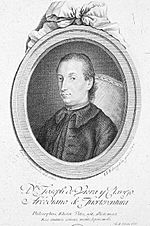José de Viera y Clavijo facts for kids
Quick facts for kids
José de Viera y Clavijo
|
|
|---|---|
 |
|
| Born | 28 December 1731 |
| Died | 21 February 1813 (aged 81) Las Palmas, Canary Islands, Napoleonic Spain
|
| Occupation | Intellectual |
| Years active | 1756–1813 |
|
Notable work
|
Historia de Canarias |
| Signature | |
 |
|
José de Viera y Clavijo (born December 28, 1731 – died February 21, 1813) was an important Spanish thinker. He was a priest, a poet, a historian, and a scientist who studied plants (a botanist). He lived during a time called the Age of Enlightenment, when people focused on reason and science.
Viera y Clavijo is most famous for his huge book, History of the Canary Islands. This amazing work took him 20 years to write! The first part came out in 1773, and the last part in 1781. He also studied how the Atlantic Ocean and sailing affected the Canary Islands. He looked into old stories about a mysterious place called Saint Brendan's Island.
Contents
Life Story of Viera y Clavijo
Viera was born in a town called Realejo Alto on the island of Tenerife. His father was a notary and the town mayor. When José was a child, his family moved to La Orotava. There, he went to school at the Santo Domingo convent. He especially liked the writings of Benito Jerónimo Feijóo y Montenegro, another famous Spanish thinker.
When he was 18, he took his first steps to become a priest. By age 25, he became a full priest in Las Palmas.
Early Career and Travels
In 1756, Viera started working as a priest in La Laguna. He stayed there for 14 years. During this time, he joined a group called the Tertulia de Nava. Here, he learned about new ideas from the Spanish Enlightenment. He also wrote many different kinds of poems.
In 1770, Viera moved to Madrid. He became a helper and teacher for a young nobleman named Francisco de Asís. For 14 years, Viera traveled all over Europe with this nobleman. He met many famous scientists and writers, like Voltaire and Charles Messier. A scientist named Antonio José Cavanilles even taught him about chemistry and nature. These lessons greatly influenced Viera's writing.
Return to the Canary Islands
In 1783, Viera y Clavijo returned to the Las Palmas Cathedral in the Canary Islands. He became an important church leader there. He never left the island again and passed away in Las Palmas on February 21, 1813. His remains are kept in the cathedral. Today, a famous botanical garden in the Canary Islands, the Jardín Botánico Canario Viera y Clavijo, is named after him.
Important Books and Writings
Here are some of the books and writings by José de Viera y Clavijo:
- Vida del noticioso Jorge Sargo, 1745
- Papel Hebdomadario, 1758 and 1759
- Memoriales del Síndico Personero, 1764
- Gacetas de Daute, 1765
- Carta filosófica sobre la Aurora boreal (A philosophical letter about the Northern Lights), 1770
- Historia de Canarias (History of the Canary Islands, 4 volumes), 1773, 1774, 1775, and 1781
- El segundo Agatócles Cortés en la Nueva España, 1778
- Elogio de Felipe V, 1779
- Elogio de Don Alonso el Pintado, 1782
- El Hyerotheo, o Tratado Histórico de los antiguos honores y derechos del Presbiterio, 1799
- Diccionario de Historia natural de las Islas Canarias (Dictionary of Natural History of the Canary Islands), 1799
- Noticias de la Tierra (News of the Earth), 1807
- Noticias del cielo (News of the Sky), 1811
- Los Vasconautas, undated
- Tragedia de Santa Genoveva, undated
See also
 In Spanish: José de Viera y Clavijo para niños
In Spanish: José de Viera y Clavijo para niños

